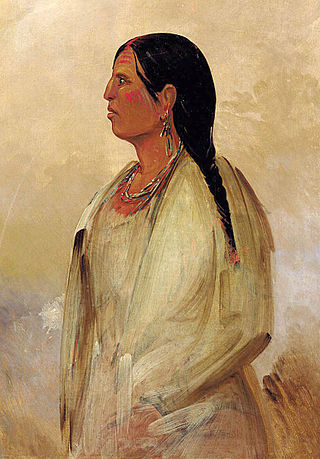Related Research Articles
Mobilian Jargon was a pidgin used as a lingua franca among Native American groups living along the Gulf of Mexico around the time of European settlement of the region. It was the main language among Native tribes in this area, mainly Louisiana. There is evidence indicating its existence as early as the late 17th to early 18th century. The Native groups that are said to have used it were the Alabama, Apalachee, Biloxi, Chacato, Pakana, Pascagoula, Taensa, Tunica, Caddo, Chickasaw, Houma, Choctaw, Chitimacha, Natchez, and Ofo. The name is thought to refer to the Mobile Indians of the central Gulf Coast, but did not originate from this group; Mobilian Jargon is linguistically and grammatically different from the language traditionally spoken by the Mobile Indians.

Tangipahoa is a village in Tangipahoa Parish, Louisiana, United States. The population was 425 at the 2020 census. It was named after the Tangipahoa Native American tribe. Tangipahoa is part of the Hammond Micropolitan Statistical Area.

Pierre Le Moyne d'Iberville or Sieur d'Iberville was a French soldier, explorer, colonial administrator, and trader. He is noted for founding the colony of Louisiana in New France. He was born in Montreal to French colonist parents.

Henri de Tonti, also spelled Henri de Tonty, was an Italian-born French military officer, explorer, and voyageur who assisted René-Robert Cavelier, Sieur de La Salle, with North American exploration and colonization from 1678 to 1686. de Tonti was one of the first explorers to navigate and sail the upper Great Lakes. He also sailed the Illinois and the Mississippi, to its mouth and thereupon claimed the length of the Mississippi for Louis XIV of France. He is credited with founding the settlement that would become Peoria, Illinois. De Tonti established the first permanent European settlement in the lower Mississippi valley, known as Poste de Arkansea, making him "The Father of Arkansas".

John Reed Swanton was an American anthropologist, folklorist, and linguist who worked with Native American peoples throughout the United States. Swanton achieved recognition in the fields of ethnology and ethnohistory. He is particularly noted for his work with indigenous peoples of the Southeast and Pacific Northwest.

The Adai were a Native American people of northwestern Louisiana and northeastern Texas. They were an Indigenous people of the Southeastern Woodlands and part of the Caddo Confederacy.
The Taposa were an Indigenous people of the Southeastern Woodlands from what is now Mississippi in the United States.

The Houma are a historic Native American people of Louisiana on the east side of the Red River of the South. Their descendants, the Houma people or the United Houma Nation, have been recognized by the state as a tribe since 1972, but are not recognized by the federal government.

Indigenous peoples of the Southeastern Woodlands, Southeastern cultures, or Southeast Indians are an ethnographic classification for Native Americans who have traditionally inhabited the area now part of the Southeastern United States and the northeastern border of Mexico, that share common cultural traits. This classification is a part of the Eastern Woodlands. The concept of a southeastern cultural region was developed by anthropologists, beginning with Otis Mason and Franz Boas in 1887. The boundaries of the region are defined more by shared cultural traits than by geographic distinctions. Because the cultures gradually instead of abruptly shift into Plains, Prairie, or Northeastern Woodlands cultures, scholars do not always agree on the exact limits of the Southeastern Woodland culture region. Shawnee, Powhatan, Waco, Tawakoni, Tonkawa, Karankawa, Quapaw, and Mosopelea are usually seen as marginally southeastern and their traditional lands represent the borders of the cultural region.
The Avoyel or Avoyelles were a small Native American tribe who at the time of European contact inhabited land near the mouth of the Red River at its confluence with the Atchafalaya River near present-day Marksville, Louisiana. The Avoyel are a member of the federally recognized Native American tribe and sovereign nation of the Tunica Biloxi Tribe of Louisiana.
The Taensa were a Native American people whose settlements at the time of European contact in the late 17th century were located in present-day Tensas Parish, Louisiana. The meaning of the name, which has the further spelling variants of Taenso, Tinsas, Tenza or Tinza, Tahensa or Takensa, and Tenisaw, is unknown. It is believed to be an autonym. The Taensa should not be confused with the Avoyel, known by the French as the petits Taensas, who were mentioned in writings by explorer Pierre Le Moyne d'Iberville in 1699. The Taensa are more closely related to the Natchez people and both are considered descendants of the late prehistoric Plaquemine culture.

The Biloxi tribe are Native Americans of the Siouan language family. They call themselves by the autonym Tanêks(a) in Siouan Biloxi language. When first encountered by Europeans in 1699, the Biloxi inhabited an area near the coast of the Gulf of Mexico near what is now the city of Biloxi, Mississippi. They were eventually forced west into Louisiana and eastern Texas. The Biloxi language--Tanêksąyaa ade--has been extinct since the 1930s, when the last known semi-speaker, Emma Jackson, died.
The Quinipissa were an Indigenous people of the Southeastern Woodlands who were living on the lower Mississippi River, in present-day Louisiana, as reported by René-Robert Cavelier, Sieur de La Salle in 1682.
The Acolapissa were a small tribe of Native Americans of North America, who lived in the Southeast of what is the present-day United States. They lived along the banks of the Pearl River, between present-day Louisiana and Mississippi. They are believed to have spoken a Muskogean language, closely related to the Choctaw and Chickasaw spoken by other Southeast tribes of the Muskogean family.

Fort Maurepas, later known as Old Biloxi, was developed in colonial French Louisiana in April 1699 along the Gulf of Mexico . Fort Maurepas was designated temporarily as the capital of Louisiana in 1699. The capital was moved from Ocean Springs to Mobile in 1710, then to New Orleans in 1723 on the Mississippi River. Government buildings in the latter city were still under construction.
Bayou Manchac is an 18-mile-long (29 km) bayou in southeast Louisiana, USA. First called the Iberville River by its French discoverers, the bayou was once a very important waterway linking the Mississippi River to the Amite River. East Baton Rouge Parish lies on its northern side, while its southern side is divided between Ascension Parish and Iberville Parish. The large unincorporated community of Prairieville and the city of St. Gabriel both lie on its southern side.
The Chakchiuma were a Native American tribe of the upper Yazoo River region of what is today the state of Mississippi.
The Okelousa were Native American people Louisiana, United States. They lived west and north of Pointe Coupee Parish, Louisiana.
The Bayogoula were a Native American tribe from Louisiana in the southern United States.
The Mougoulacha were a Native American tribe that lived near Lake Pontchartrain in Louisiana.
References
- ↑ Bulletin - Smithsonian Institution. Bureau of American Ethnology. U.S. Government Printing Office. 1909. p. 2.
- ↑ William M. Denevan (1 March 1992). The Native Population of the Americas in 1492. Univ of Wisconsin Press. pp. 264–. ISBN 978-0-299-13433-4.
- ↑ William A. Read (12 October 2008). Louisiana Place Names of Indian Origin: A Collection of Words. University of Alabama Press. pp. 61–. ISBN 978-0-8173-5505-0.
- ↑ Benjamin Franklin French (1875). Historical Collections of Louisiana and Florida: Including Translations of Original Manuscripts Relating to Their Discovery and Settlement, with Numerous Historical and Biographical Notes. A. Mason. pp. 23–.
- ↑ Frederick Webb Hodge (1910). Handbook of American Indians North of Mexico: N-Z. U.S. Government Printing Office. p. 685.
- ↑ Joseph Norman Heard (1987). Handbook of the American Frontier: The southeastern woodlands . Scarecrow Press. p. 5. ISBN 978-0-8108-1931-3.
- ↑ Native Languages of the Americas website. "Tangipahoa Indians". Native Languages of the Americas website. Retrieved 2018-04-24.
- ↑ Native Languages of the Americas website. "ACOLAPISSA HISTORY". Jordan S. Dill. Retrieved 2018-04-24.